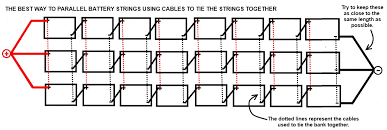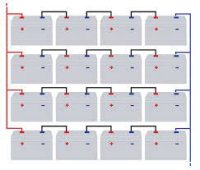You are using an out of date browser. It may not display this or other websites correctly.
You should upgrade or use an alternative browser.
You should upgrade or use an alternative browser.
equal cable lengths for parallel batteries?
- Thread starter ljwobker
- Start date
Warpspeed
Solar Wizard
Yes it does, its the usual way that it is done.
N1 must equal P1, this is usually very easy to do because the connections are usually short and symmetrical.
N0 and P0 can be any length and do not need to be the same.
N1 must equal P1, this is usually very easy to do because the connections are usually short and symmetrical.
N0 and P0 can be any length and do not need to be the same.
MrM1
I'm Here, But I'm Not All There
That is "A" way. There are pros and cons to each
Well that's sufficiently vague as to be not-terribly-useful. I (obviously) have no idea how this works, but responding to a helpful comment saying "well that's one way but might not be a great idea" without any supporting detail doesn't seem particularly beginner-friendly 
chrisski
Solar Boondocker
- Joined
- Aug 14, 2020
- Messages
- 5,225
In my signature block there's a link on paralleling batteries or go to Victron Wiring Unlimited.Well that's sufficiently vague as to be not-terribly-useful. I (obviously) have no idea how this works, but responding to a helpful comment saying "well that's one way but might not be a great idea" without any supporting detail doesn't seem particularly beginner-friendly
Warpspeed
Solar Wizard
One satisfactory alternative might be the picture "battery1" although its not the way its usually done.
Common industry practice looks more like "battery2".
The Vicrton advice given the previous post is technically WRONG, which is rather a surprise coming from them.
Common industry practice looks more like "battery2".
The Vicrton advice given the previous post is technically WRONG, which is rather a surprise coming from them.
Attachments
Last edited:
chrisski
Solar Boondocker
- Joined
- Aug 14, 2020
- Messages
- 5,225
For only two batteries in parallel, as long as cables are opposite of each other like pictured in the OPs post, I doubt any of the alternate configurations listed by @Warpspeed or myself have any measurable effect and would not be worth any additional wiring expense.
Warpspeed
Solar Wizard
Yup.
The original poster had it right.
And I agree, for a simple two battery system its not going to make much difference anyway.
But technically there are right and wrong ways of doing things.
Engineering is like that.
The original poster had it right.
And I agree, for a simple two battery system its not going to make much difference anyway.
But technically there are right and wrong ways of doing things.
Engineering is like that.
Warpspeed
Solar Wizard
Yes, that is like the above picture "battery1" and is perfectly correct.If you attach to a bus bar then I was told positives same length, negatives same length. Positive length can be different than negative length in this case
MrM1
I'm Here, But I'm Not All There
I posted a link to several other ways in the post above. So not sure what you mean. As a total Noob myself, that info (in the link I posted above) is still some of the best info I ever found. YMMV I guess.Well that's sufficiently vague as to be not-terribly-useful. I (obviously) have no idea how this works, but responding to a helpful comment saying "well that's one way but might not be a great idea" without any supporting detail doesn't seem particularly beginner-friendly
Last edited:
I have parallel split phase 6500's. All of my batteries to bus bars are equal length. Positive and negative cables are the same length to the bus bars with 4/0. The positive cables from the buss bars to the inverters are the same, but one of the negatives is 2 inches shorter than the other. These are 2/0.
Does 2 inches matter? ............ (I expect some joke replies)
Does 2 inches matter? ............ (I expect some joke replies)
RCinFLA
Solar Wizard
- Joined
- Jun 21, 2020
- Messages
- 3,565
You're more likely to have variation in terminal lugs and clamping connections of lugs.I have parallel split phase 6500's. All of my batteries to bus bars are equal length. Positive and negative cables are the same length to the bus bars with 4/0. The positive cables from the buss bars to the inverters are the same, but one of the negatives is 2 inches shorter than the other. These are 2/0.
Does 2 inches matter? ............ (I expect some joke replies)
Fractions of milliohms difference matters. Inverters regulate their output AC voltage so more DC cable voltage drop means more battery current is required by inverter to produce the same AC output power with lower DC voltage input to inverter. Inverter conversion efficiency drops for lower DC voltage input.
The object on parallel battery hook up is to get balanced current. Some imbalance will be due to batteries themself due to mismatching of their terminal overpotential voltage slump vs. load current demand. Older LFP battery will likely have greater internal impedance causing it to contribute less current to the parallel combination of batteries.
Don't forget connectors and bus bars connection resistance. A poor bus bar connection can screw up the current sharing between batteries a lot.
It is tough to get better than +/-10% current matching. Better than +/-20% matching is fairly satisfactory.
If you use separate BMS's on each parallel battery array they can help with parallel battery current balancing. The greater the current through the BMS the hotter their series MOSFET switches get. The hotter the MOSFET's gets the greater their series resistance. For parallel batteries with their own BMS, if one battery hogs more of the current, the BMS series resistance will increase due to heating, lowering that battery's dominance of supply current.
This assumes the BMS's start with similar series resistance MOSFET's. Particularly, if you use different manufacturer's BMS's between batteries they are not likely going to be matched in series resistance.
Last edited:
meetyg
Solar Addict
- Joined
- Jun 4, 2021
- Messages
- 1,101
I have a related question, not sure if it requires a separate thread:
If I have two batteries, each goes to its own two pole DC circuit breaker. Then, those two breakers go to busbars (one for negative one for positive). Think of the breakers being side by side, around 15cm apart. Then the positive bus bar is above the right breaker and negative is above the left.
Because of how it's layed out (sorry don't have a picture at hand), it would be easiest for the each breaker to have a short wire/cable going out one terminal straight to the above busbar, and another longer cable to the farther busbar.
Is this OK ?
Sorry for this horrible drawing, but I think it helps explain my scenario:

Wires from each battery to CB will be equal length.
If I have two batteries, each goes to its own two pole DC circuit breaker. Then, those two breakers go to busbars (one for negative one for positive). Think of the breakers being side by side, around 15cm apart. Then the positive bus bar is above the right breaker and negative is above the left.
Because of how it's layed out (sorry don't have a picture at hand), it would be easiest for the each breaker to have a short wire/cable going out one terminal straight to the above busbar, and another longer cable to the farther busbar.
Is this OK ?
Sorry for this horrible drawing, but I think it helps explain my scenario:

Wires from each battery to CB will be equal length.
The Good Package
New Member
You should invest in bus bars. As long as each individual battery's own pos/neg cable length to the bus bars is close, you're fine. Each battery's distance to the bus bar can differ from others but they should be similar to equalize amp draw (matters little under 5 feet). If you're paralleling inverters, then pos/neg length of each should be very close to ensure best sync.
Obsessing over cable lengths and sizes is the leading cause of failed marriages globally.
Obsessing over cable lengths and sizes is the leading cause of failed marriages globally.
Similar threads
- Replies
- 5
- Views
- 337
- Replies
- 7
- Views
- 1K
- Replies
- 9
- Views
- 374





